Genesis of W Mineralization in the Caledonian Granite Porphyry of the Chuankou W Deposit, South China: Insights from Fluid Inclusions and C–H–O–S Isotopes
Abstract
1. Introduction
2. Geological Background
2.1. Regional Geology
2.2. Deposit Geology
3. Sampling and Analytical Methods
3.1. Sampling
3.2. Fluid Inclusion and Raman Spectroscopy Analysis
3.3. C–H–O Isotope Analysis
3.4. S Isotope Analysis
4. Results
4.1. Fluid Inclusion Petrography
4.2. Microthermometry and Raman Spectroscopy
4.3. C–H–O Isotopic Compositions
4.4. S Isotopic Compositions
5. Discussion
5.1. Nature and Evolution of the Ore-Forming Fluids
5.2. Origin of the Ore-Forming Materials and Fluids
5.3. Genesis of W Mineralization in the Caledonian Granite Porphyry
6. Conclusions
- (1)
- Microthermometry results of fluid inclusions with scheelite and quartz from two stages show that the average homogenization temperature in the quartz-veins within the Caledonian granite porphyry is 248 °C, and the average salinity is 6.31 wt.% NaCl eq (N = 85), the average homogenization temperature in the quartz-veins within the slate is 219 °C, and the average salinity is 5.57 wt.% NaCl eq (N = 49). The ore-forming fluids experienced an evolution from high temperature and high salinity to low temperature and low salinity.
- (2)
- Sulfur isotope compositions show that the δ34S values of pyrite and arsenopyrite in the quartz-veins within the Caledonian granite porphyry are 2.06 to 3.28‰ and −0.38 to 0.21‰, respectively, and the δ34S value of pyrite in the quartz-veins within the slate is −1.72 to 0.47‰. The δ34S values of each stage are close to 0‰, indicating that the origin of sulfur mainly from magma.
- (3)
- The H-O isotope composition of the quartz indicates that the ore-forming fluid was primarily magmatic water. The low δ18OH2O values (1.74 to 1.58‰) are influenced by fluid-rock interactions or the incorporation of atmospheric precipitation. The carbon isotopes (δ13C =−9.5 to −8.3‰) indicate a magmatic origin, but the C isotopes of quartz in the quartz-veins within the slate shift toward sedimentary rocks, reflecting the incorporation of rock components in the late mineralization period. These isotopic differences indicate that the fluid–rock interaction gradually strengthened during fluid evolution.
Author Contributions
Funding
Data Availability Statement
Conflicts of Interest
References
- Jiang, S.Y.; Zhao, K.D.; Jiang, H.; Su, H.M.; Xiong, S.F.; Xiong, Y.Q.; Xu, Y.M.; Zhang, W.; Zhu, Y.L. Research progress on the spatiotemporal distribution, geological characteristics and mineralization mechanism of tungsten-tin deposits in China. Chin. Sci. Bull. 2020, 65, 3730–3745, (In Chinese with English Abstract). [Google Scholar]
- Peng, N.L.; Wang, X.H.; Yang, J.; Chen, D.; Luo, L.; Luo, P.; Liu, T.Y. Re-Os dating of molybdenite from Sanjiaotan tungsten deposit in Chuankou area, Hunan Province, and its geological implications. Miner. Depos. 2017, 36, 1402–1414, (In Chinese with English Abstract). [Google Scholar]
- Qin, J.H.; Wang, D.H.; Li, C.; Chen, Y.C.; Cai, F.C. The Molybdenite Re-Os Isotope Chronology, in Situ Scheelite and Wolframite Trace Elements and Sr Isotope Characteristics of the Chuankou Tungsten Ore Field, South China. Ore Geol. Rev. 2020, 126, 103756. [Google Scholar] [CrossRef]
- Cheng, J. Mining Technology Study of Inclined Medium-Thick Orebody in Yanglinao Mining Area of Chuankou Tungsten Mine. Master’s Thesis, Central South University, Changsha, China, 2014. (In Chinese with English Abstract). [Google Scholar]
- Mao, W.J.; Xiong, Y.Q.; Shao, Y.J.; Brzozowski, M.J.; He, Q.; Di, H.F.; Fan, Z.W.; Mao, Y.J.; Fang, W.J. Reworking of a Caledonian (Early Paleozoic) granodiorite porphyry in a collisional zone in South China and its contribution for tungsten mineralization. J. Asian Earth Sci. 2024, 276, 106356. [Google Scholar] [CrossRef]
- Xiong, Y.Q.; Shao, Y.J.; Zhou, H.D.; Wu, Q.H.; Liu, J.P.; Wei, H.T.; Zhao, R.C.; Cao, J.Y. Ore-forming mechanism of quartz-vein-type W-Sn deposits of the Xitian district in SE China: Implications from the trace element analysis of wolframite and investigation of fluid inclusions. Ore Geol. Rev. 2017, 83, 152–173. [Google Scholar] [CrossRef]
- Lin, S.F.; Xing, G.F.; Davis, D.W.; Yin, C.Q.; Wu, M.L.; Li, L.M.; Jiang, Y.; Chen, Z.H. Appalachian-Style Multi-Terrane Wilson Cycle Model for the Assembly of South China. Geology 2018, 46, 319–322. [Google Scholar] [CrossRef]
- Mao, J.W.; Cheng, Y.B.; Chen, M.H.; Pirajno, F. Major types and time-space distribution of Mesozoic ore deposits in South China and their geodynamic settings. Miner. Depos. 2013, 48, 267–294. [Google Scholar]
- Xiong, Y.Q.; Shao, Y.J.; Cheng, Y.; Jiang, S.Y. Discrete Jurassic and Cretaceous Mineralization Events at the Xiangdong W(-Sn) Deposit, Nanling Range, South China. Econ. Geol. 2020, 115, 385–413. [Google Scholar] [CrossRef]
- Shu, L.S.; Zhou, X.M.; Deng, P.; Yu, X.Q. Principal geological features of Nanling tectonic belt, south China. Geol. Rev. 2006, 52, 251–265, (In Chinese with English Abstract). [Google Scholar]
- Di, H.F.; Shao, Y.J.; David, C.; Chen, J.F.; Fang, W.J.; Xiong, Y.Q. Genesis and magmatic-hydrothermal evolution of the Silurian Pingtan W deposit, Nanling Range, South China: Constraints from scheelite and apatite geochemistry and geochronology. J. Geochem. Explor. 2025, 279, 107884. [Google Scholar] [CrossRef]
- Xiong, Y.Q.; Fan, Z.W.; Yu, H.Y. Genetic linkage between parent granite and zoned rare metal pegmatite in the Renli-Chuanziyuan granite-pegmatite system, South China. Geol. Soc. Am. Bull. 2025, 137, 1607–1627. [Google Scholar] [CrossRef]
- Mao, J.W.; Xie, G.Q.; Guo, C.L.; Chen, Y.C. Large-scale tungsten-tin mineralization in the South China: Metallogenic ages and corresponding geodynamic processes. Acta Petrol. Sin. 2007, 23, 2329–2338, (In Chinese with English Abstract). [Google Scholar]
- Hua, R.M.; Zhang, W.L.; Chen, P.R.; Zhai, W.; Li, G.L. Relationship between Caledonian granitoids and large-scale mineralization in South China. Geol. J. China Univ. 2013, 19, 1–11, (In Chinese with English Abstract). [Google Scholar]
- Chen, J.; Wang, R.C.; Zhu, J.C.; Lu, J.J.; Ma, D.S. Multiple-Aged Granitoids and Related Tungsten-Tin Mineralization in the Nanling Range, South China. Science China. Earth Sci. 2013, 56, 2045–2055. [Google Scholar]
- Yuan, S.D.; Williams-Jones, A.E.; Romer, R.L.; Zhao, P.L.; Mao, J.W. Protolith-Related Thermal Controls on the Decoupling of Sn and W in Sn-W Metallogenic Provinces: Insights from the Nanling Region, China. Econ. Geol. 2019, 114, 1005–1012. [Google Scholar] [CrossRef]
- Zhang, W.L.; Wang, R.C.; Lei, Z.H.; Hua, R.M.; Zhu, J.C.; Lu, J.J.; Xie, L.; Che, X.D.; Zhang, R.Q.; Yao, Y.; et al. Zircon U–Pb dating confirms existence of a Caledonian scheelite-bearing aplitic vein in the Penggongmiao granite batholith, South Hunan. Chin. Sci. Bull. 2011, 56, 2031–2036. [Google Scholar] [CrossRef]
- Chen, J.F.; Shao, Y.J.; Xiong, Y.Q.; He, H.S.; Brzozowski, M.J.; Wen, C.H.; Zhou, L.T.; Lu, W.; Shi, J.H. Mechanisms of ore formation in Silurian (Caledonian) scheelite deposits of the Nanling Range, South China: A case study from the Pingtan W deposit. Ore Geol. Rev. 2023, 154, 105347. [Google Scholar] [CrossRef]
- Wang, C. Study on Indosinian Granite and Its Tungsten Mineralization in Central Hunan, South China. Ph.D. Thesis, Central South University, Changsha, China, 2022. (In Chinese with English Abstract). [Google Scholar]
- Di, H.F.; Shao, Y.J.; Jiang, S.Y.; Brzozowski, M.J.; Wang, Z.L.; Xiong, Y.Q. Identifying superimposed W–Sn mineralization events using cassiterite microtextures, trace-element chemistry, and geochronology. Ore Geol. Rev. 2023, 153, 105281. [Google Scholar] [CrossRef]
- Ni, P.; Pan, J.Y.; Han, L.; Cui, J.M.; Gao, Y.; Fan, M.S.; Li, W.S.; Chi, Z.; Zhang, K.H.; Cheng, Z.L.; et al. Tungsten and tin deposits in South China: Temporal and spatial distribution, metallogenic models and prospecting directions. Ore Geol. Rev. 2023, 157, 105453. [Google Scholar] [CrossRef]
- Yuan, S.D.; Williams-Jones, A.E.; Mao, J.W.; Zhao, P.L.; Zhang, D.L. The Origin of the Zhangjialong Tungsten Deposit, South China: Implications for W-Sn Mineralization in Large Granite Batholiths. Econ. Geol. 2018, 113, 1193–1208. [Google Scholar] [CrossRef]
- Bai, D.Y.; Wang, Y.Q.; Wang, X.H.; Ma, T.Q.; Zhang, X.Y. Geochemistry, petrogenesis and tectonic setting of the early Yanshanian peraluminous granites in the Chuankou region, Hengyang, Hunan. Sediment. Geol. Tethyan Geol. 2007, 27, 49–59, (In Chinese with English Abstract). [Google Scholar]
- Liu, Z. Study on the Ore-Controlling Structure of Sanjiaotan Tungsten Deposit in Chuankou, Hunan Province. Master’s Thesis, Central South University, Changsha, China, 2012. (In Chinese with English Abstract). [Google Scholar]
- Wen, T.; Xu, H.; Li, T.; Liu, S.L.; Kong, H. Mineralization regularities and promising prospecting areas of tungsten deposit, Chuankou ore fields, Hunan. World Nonferrous Met. 2017, 7, 105–107, (In Chinese with English Abstract). [Google Scholar]
- Deng, X.W. Study on the Mineralization Mechanism of Xiaosanjiaotan Mining Area in Chuankou Tungsten Mine, Hunan Province. Master’s Thesis, Central South University, Changsha, China, 2009. (In Chinese with English Abstract). [Google Scholar]
- Zheng, P.; Xu, H.Z.; Huang, M.X. Studies on the genesis and metallogenic model of Yanglin’ao tungsten deposit, Hengnan, Hunan province. Miner. Resour. Geol. 2007, 21, 126–130, (In Chinese with English Abstract). [Google Scholar]
- Hua, R.M.; Li, G.L.; Zhang, W.L.; Hu, D.Q.; Chen, P.R.; Chen, W.F.; Wang, X.D. A tentative discussion on differences between large-scale tungsten and tin mineralizations in South China. Miner. Depos. 2010, 29, 9–23, (In Chinese with English Abstract). [Google Scholar]
- Zhou, X.H. Study on the Ore-Forming Fluids and Mineralization Processes of the Indosinian Yanglin’ao Super-Large Tungsten Deposit in South China. Master’s Thesis, China University of Geosciences, Wuhan, China, 2021. (In Chinese with English Abstract). [Google Scholar]
- Li, W.S.; Ni, P.; Pan, J.Y.; Benedetto, D.E.; Albanese, S.; Fan, M.S.; Gao, Y.; Zhang, D.X.; Chi, Z. Co-genetic formation of scheelite- and wolframite-bearing quartz veins in the Chuankou W deposit, South China: Evidence from individual fluid inclusion and wall-rock alteration analysis. Ore Geol. Rev. 2022, 142, 104723. [Google Scholar] [CrossRef]
- Clayton, R.N.; O’Neil, J.R.; Mayeda, T.K. Oxygen isotope exchange between quartz and water. J. Geophys. Res. 1972, 77, 3057–3067. [Google Scholar] [CrossRef]
- Dewaele, S.; Clercq, F.D.; Hulsbosch, N.; Piessens, K.; Boyce, A.; Burgess, R.; Muchez, P. Genesis of the vein-type tungsten mineralization at Nyakabingo (Rwanda) in the Karagwe-Ankole Belt, Central Africa. Miner. Depos. 2016, 51, 283–307. [Google Scholar] [CrossRef]
- Heinrich, C.A. The chemistry of hydrothermal tin(-tungsten) ore deposition. Econ. Geol. 1990, 85, 457–481. [Google Scholar] [CrossRef]
- Di, H.F.; Shao, Y.J.; Xiong, Y.Q.; Zheng, H.; Fang, X.; Fang, W.J. Scheelite as a microtextural and geochemical tracer of multistage ore-forming processes in skarn mineralization: A case study from the giant Xintianling W deposit, South China. Gondwana Res. 2024, 136, 104–125. [Google Scholar] [CrossRef]
- Hoefs, J. Stable Isotope Geochemistry, 6th ed.; Springer: Berlin/Heidelberg, Germany, 2009; pp. 1–285. [Google Scholar]
- Ohmoto, H. Systematics of Sulfur and Carbon Isotopes in Hydrothermal Ore Deposits. Econ. Geol. 1972, 67, 551–578. [Google Scholar] [CrossRef]
- Song, G.; Qin, K.; Li, G.; Evans, N.J.; Chen, L. Scheelite elemental and isotopic signatures: Implications for the genesis of skarn-type W-Mo deposits in the Chizhou Area, Anhui Province, Eastern China. Am. Mineral. 2014, 99, 303–317. [Google Scholar] [CrossRef]
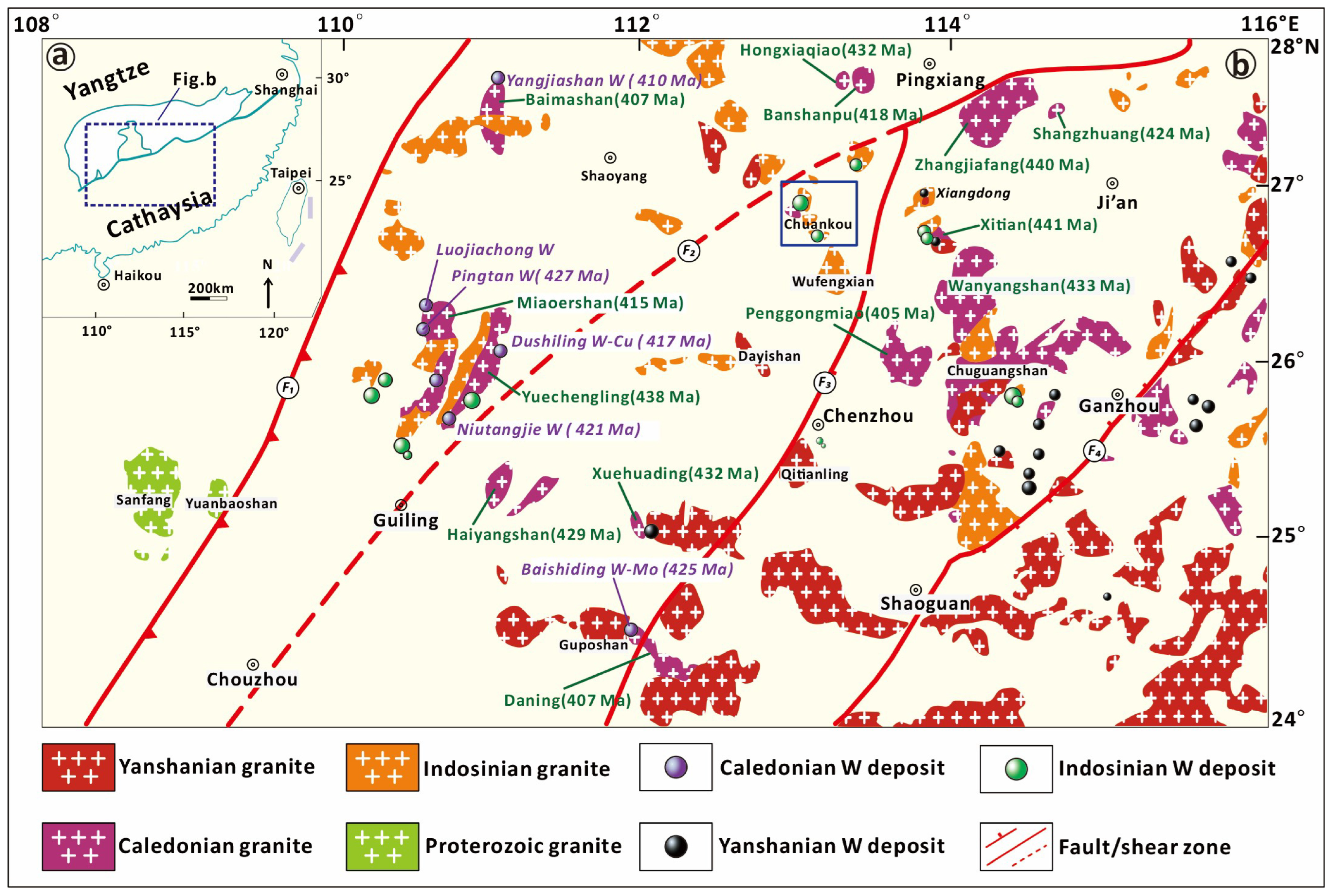
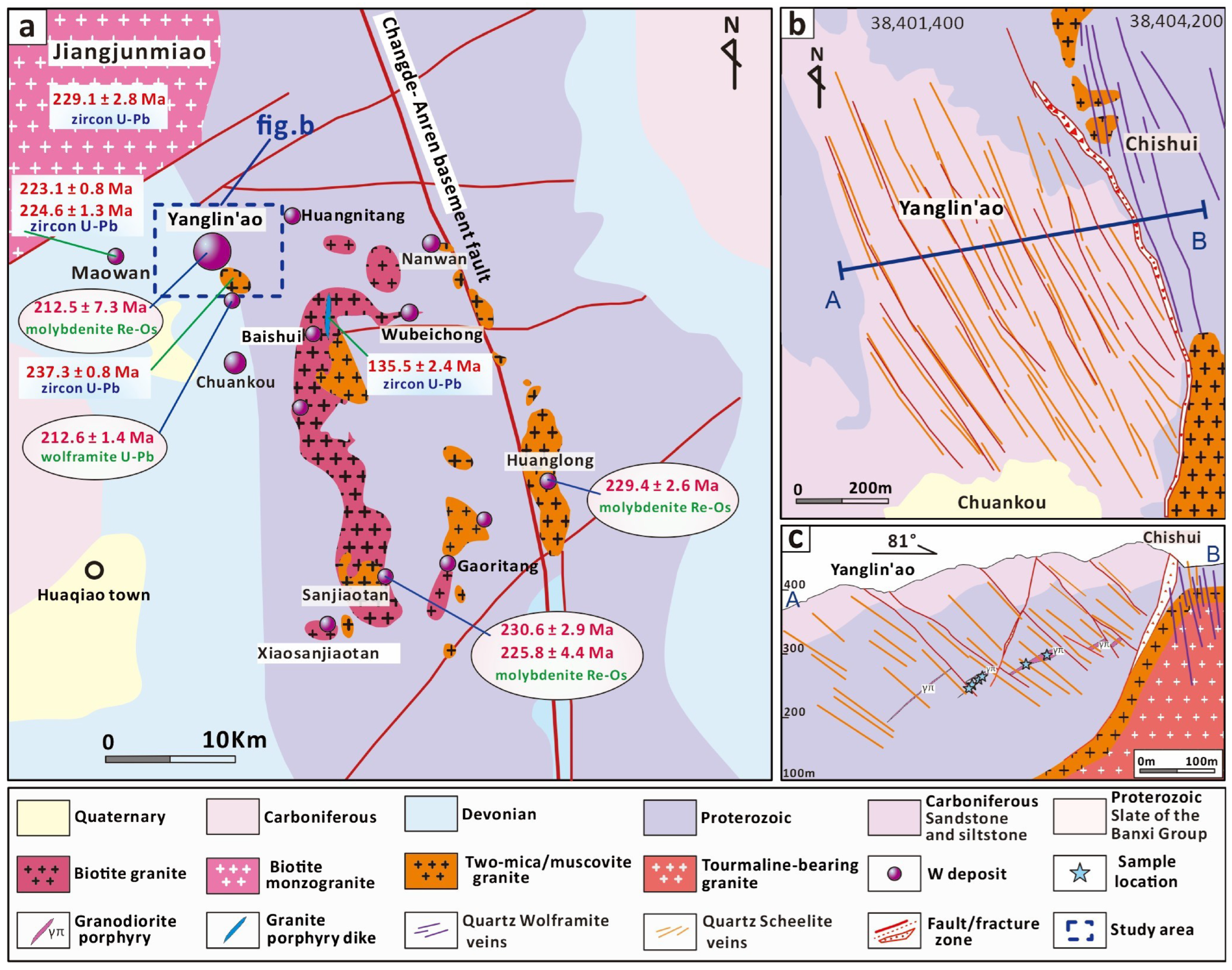
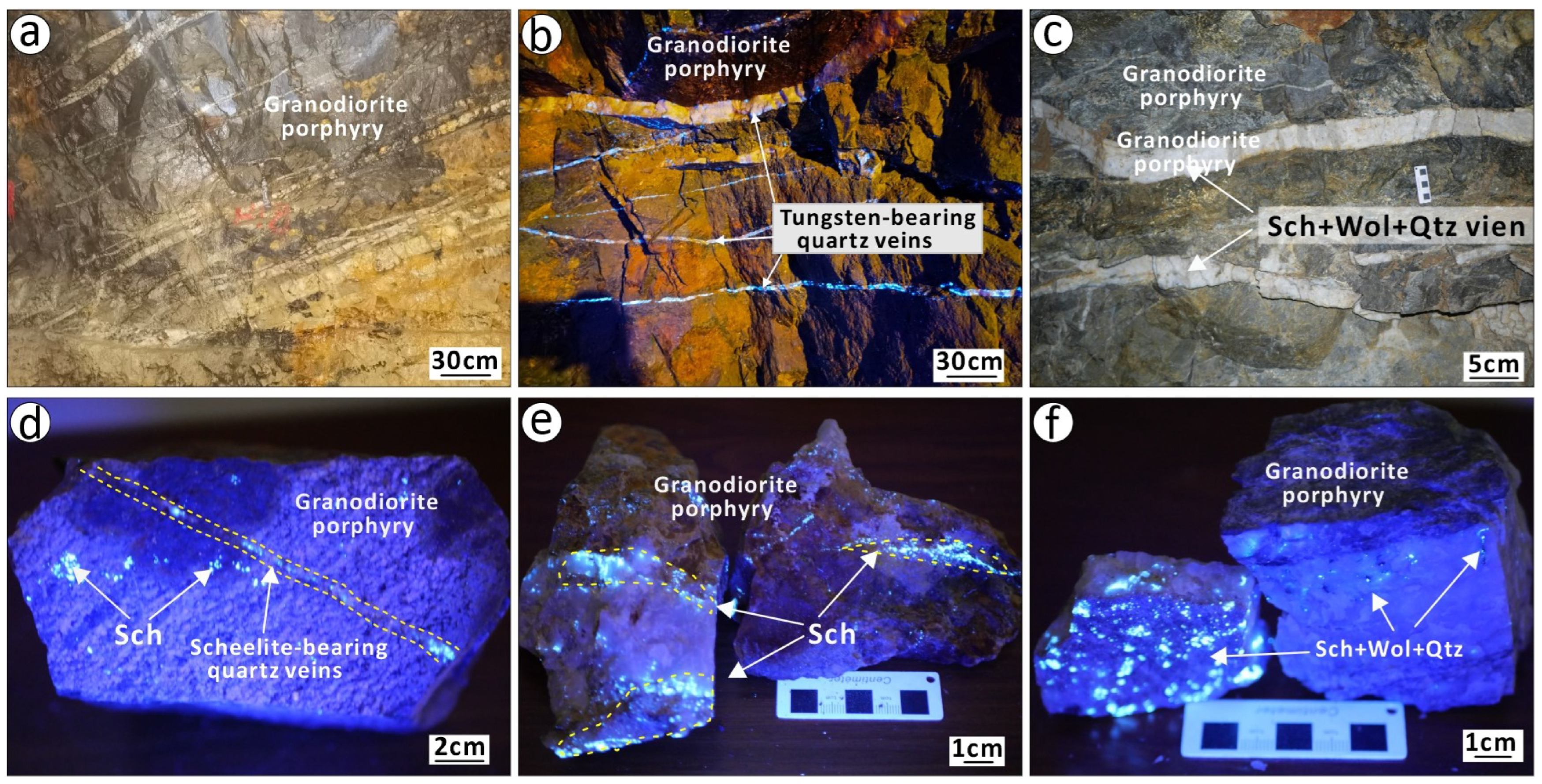

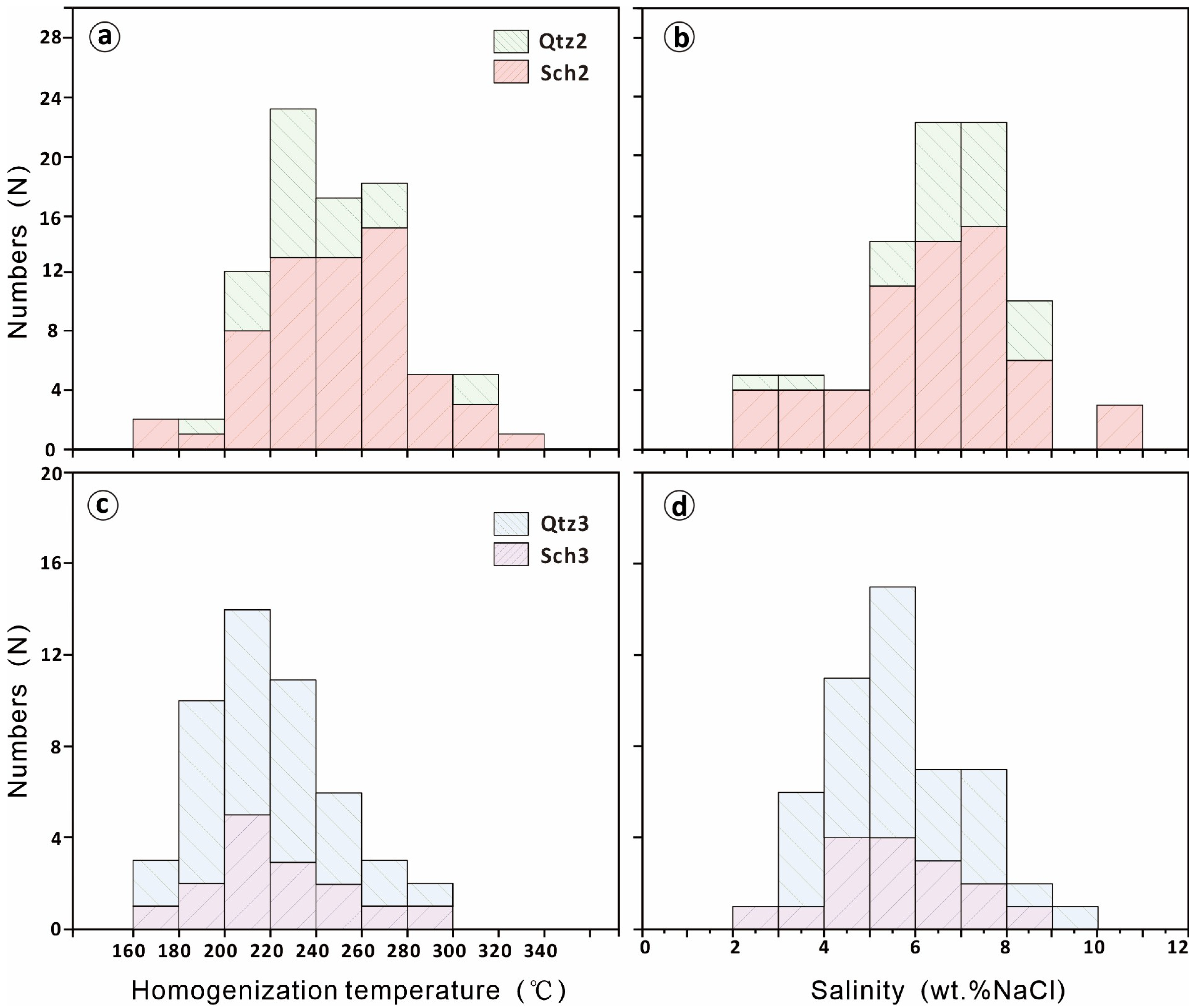

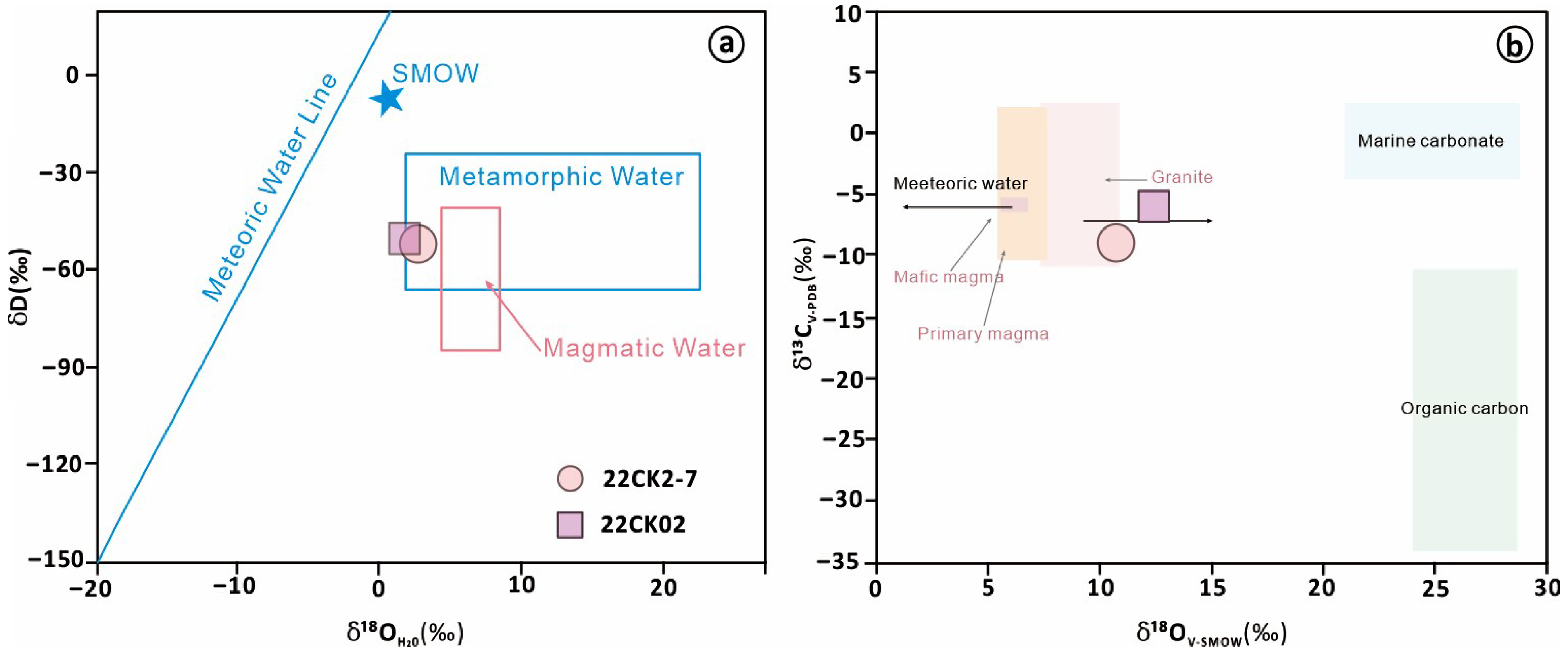
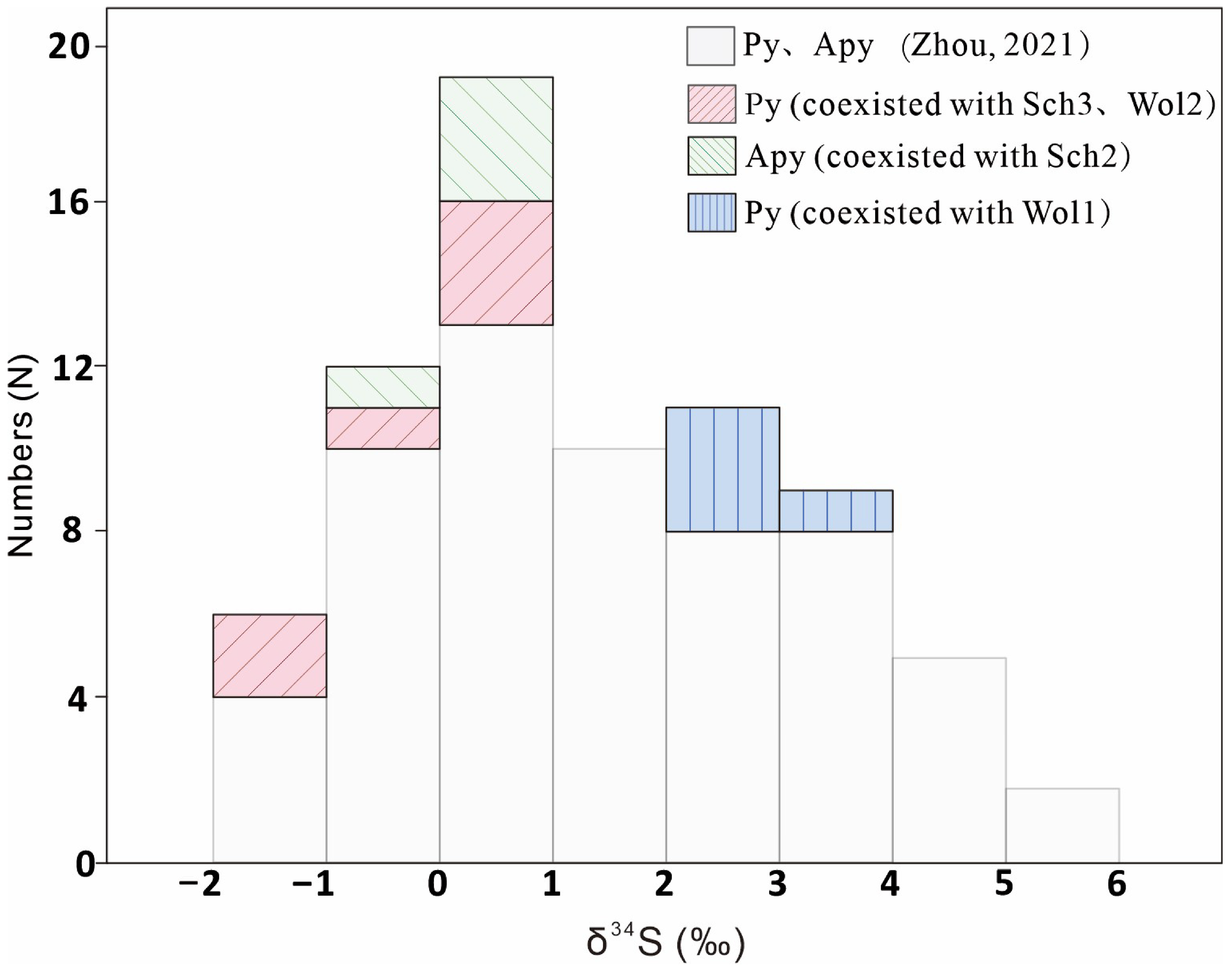

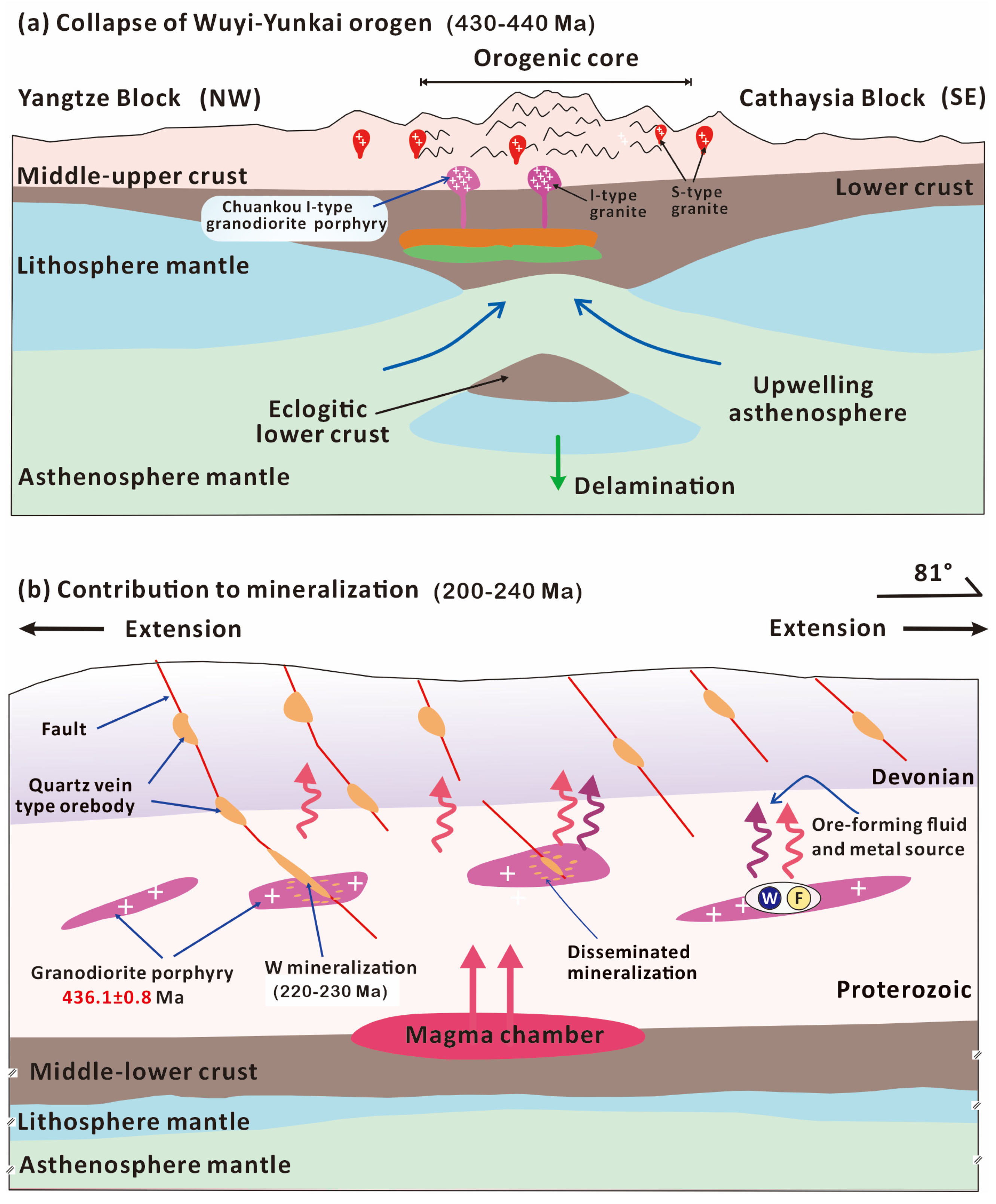
| Stage | Mineral (Number) | Size (μm) | Tm, ice (°C) | Th, tot (°C) | Salinity (wt.% eqv) |
|---|---|---|---|---|---|
| II | Sch2 (61) | 2~15 | −7.1~−1.4 | 172~326 (avg. 250) | 2.41~10.61 (avg. 6.26) |
| Qtz2 (24) | 2~10 | −5.4~−1.5 | 198~313 (avg. 242) | 2.57~8.41 (avg. 6.70) | |
| III | Sch3 (15) | 2~8 | −5.8~−1.6 | 165~285 (avg. 223) | 2.74~8.95 (avg. 5.56) |
| Qtz3 (34) | 2~8 | −5.1~−1.9 | 163~289 (avg. 218) | 3.23~9.60 (avg. 5.60) |
| Sample | Mineral | δDV-SMOW‰ | δ18OV-PDB‰ | δOV-SMOW‰ | δ18OH2O‰ | δ13CV-PDB‰ |
|---|---|---|---|---|---|---|
| 22CK2-7 | quartz | −53.5 | −19.9 | 10.3 | 1.74 | −9.5 |
| 22CK02 | quartz | −53.1 | −18.2 | 12.2 | 1.58 | −8.3 |
| Sample | Mineral | δ34S |
|---|---|---|
| 22CK2-7-1-1 | Apy1 | −0.38 |
| 22CK2-7-1-2 | Apy1 | 0.10 |
| 22CK2-7-1-3 | Apy1 | 0.10 |
| 22CK2-7-1-4 | Apy1 | 0.21 |
| 22CK2-7-2-1 | Py1 | 2.06 |
| 22CK2-7-2-2 | Py1 | 3.28 |
| 22CK2-7-2-3 | Py1 | 2.96 |
| 22CK2-7-2-4 | Py1 | 2.45 |
Disclaimer/Publisher’s Note: The statements, opinions and data contained in all publications are solely those of the individual author(s) and contributor(s) and not of MDPI and/or the editor(s). MDPI and/or the editor(s) disclaim responsibility for any injury to people or property resulting from any ideas, methods, instructions or products referred to in the content. |
© 2025 by the authors. Licensee MDPI, Basel, Switzerland. This article is an open access article distributed under the terms and conditions of the Creative Commons Attribution (CC BY) license (https://creativecommons.org/licenses/by/4.0/).
Share and Cite
Liu, W.; Wang, Y.; Shao, Y.-J.; Mao, W.-J.; Liu, Z. Genesis of W Mineralization in the Caledonian Granite Porphyry of the Chuankou W Deposit, South China: Insights from Fluid Inclusions and C–H–O–S Isotopes. Appl. Sci. 2025, 15, 10553. https://doi.org/10.3390/app151910553
Liu W, Wang Y, Shao Y-J, Mao W-J, Liu Z. Genesis of W Mineralization in the Caledonian Granite Porphyry of the Chuankou W Deposit, South China: Insights from Fluid Inclusions and C–H–O–S Isotopes. Applied Sciences. 2025; 15(19):10553. https://doi.org/10.3390/app151910553
Chicago/Turabian StyleLiu, Wei, Yi Wang, Yong-Jun Shao, Wen-Jing Mao, and Zhongfa Liu. 2025. "Genesis of W Mineralization in the Caledonian Granite Porphyry of the Chuankou W Deposit, South China: Insights from Fluid Inclusions and C–H–O–S Isotopes" Applied Sciences 15, no. 19: 10553. https://doi.org/10.3390/app151910553
APA StyleLiu, W., Wang, Y., Shao, Y.-J., Mao, W.-J., & Liu, Z. (2025). Genesis of W Mineralization in the Caledonian Granite Porphyry of the Chuankou W Deposit, South China: Insights from Fluid Inclusions and C–H–O–S Isotopes. Applied Sciences, 15(19), 10553. https://doi.org/10.3390/app151910553






